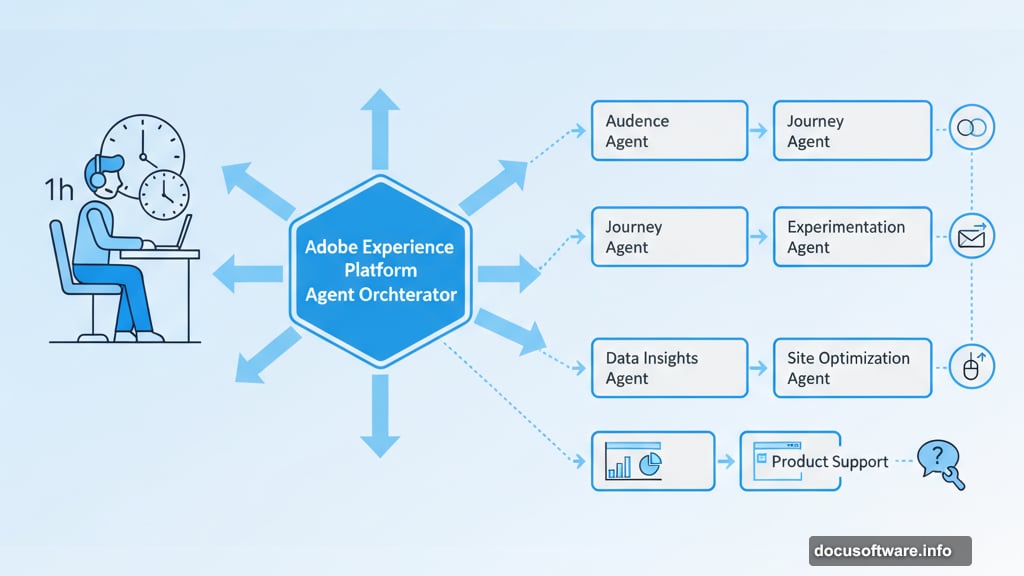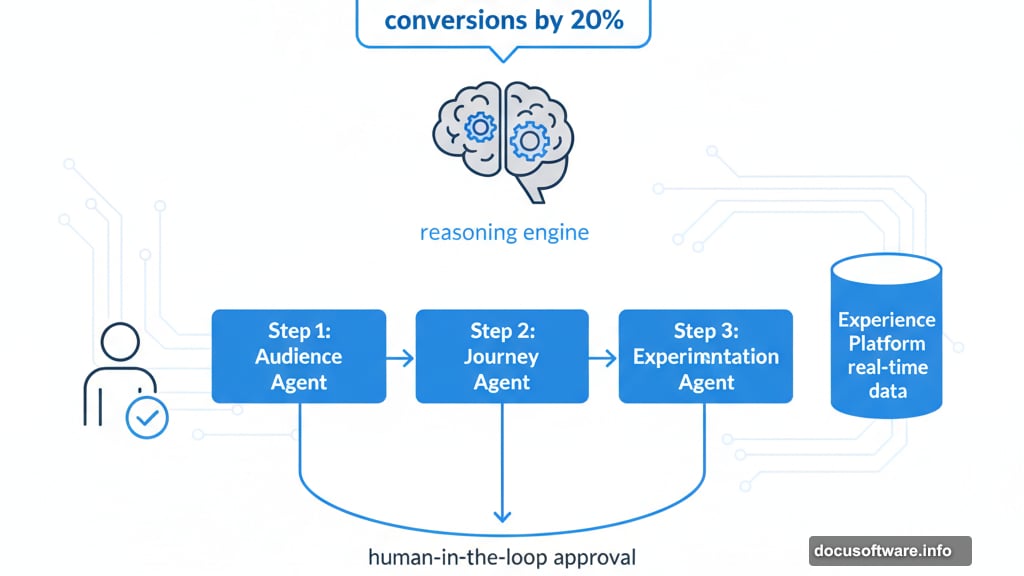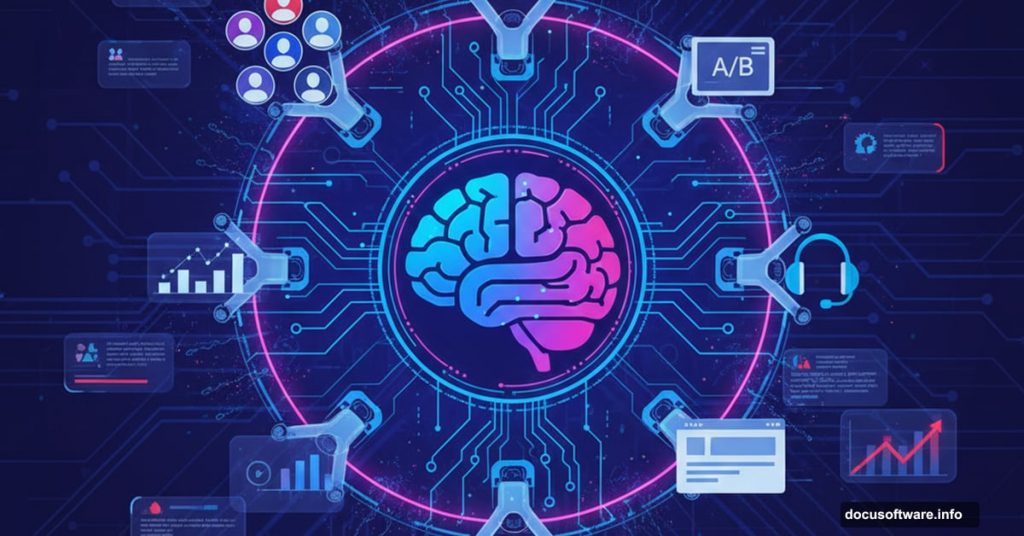Adobe dropped something big on September 2025.. AI agents that actually do the work, not just suggest it.
These aren’t chatbots. They’re autonomous systems that build audiences, create customer journeys, and optimize campaigns while you sleep. Plus, they’re available now for businesses using Adobe Experience Platform.
Over 70% of eligible customers already use Adobe’s AI Assistant. Now those same companies get access to specialized agents that handle tasks marketers currently spend hours on manually. Companies like Hershey, Lenovo, and Wegmans are already testing them.
What These Agents Actually Do
Adobe built six specialized agents, each focused on specific marketing tasks. They don’t just analyze data. They take action.
Audience Agent creates and scales customer segments automatically. It recommends high-value audiences based on your goals and monitors performance. So instead of spending days building audience lists, marketers define objectives and let the agent handle execution.
Journey Agent designs entire customer journeys across email, web, mobile, and apps. It optimizes touchpoints when customers drop off and suggests improvements. That’s powerful because journey orchestration typically requires specialized skills and constant tweaking.
Experimentation Agent analyzes A/B tests and hypothesizes new optimization ideas. It predicts conversion impact before you run experiments. Most companies struggle to scale testing because analysis takes too long. This agent removes that bottleneck.
Moreover, Data Insights Agent turns raw signals into visualizations and forecasts. Any team member can query data using natural language and get actionable insights. No SQL knowledge required.
Site Optimization Agent monitors websites 24/7, detecting broken links and underperforming pages. It flags issues automatically so teams can fix problems before customers notice them.
Finally, Product Support Agent helps users troubleshoot Adobe products directly in their workflow. It creates support cases and tracks resolution without leaving the application.
The Brain Behind the Agents
Adobe Experience Platform Agent Orchestrator powers everything. Think of it as the conductor coordinating multiple agents.
It uses a reasoning engine that interprets natural language prompts. So when you ask “increase email conversions by 20%,” it determines which agents to activate and in what sequence. The system plans multi-step actions and refines responses based on results.
Plus, Adobe built this on Experience Platform, where many large enterprises already manage customer data. That matters because agents need context to take smart actions. They access real-time data across the organization instead of working in isolation.
Adobe also supports “human-in-the-loop” workflows. Agents propose actions but teams review and approve before execution. That balance between automation and control addresses the biggest concern companies have about autonomous AI.

The Platform Play Nobody Saw Coming
Here’s where Adobe’s strategy gets interesting. They’re not just building agents for their own products.
Coming soon, Experience Platform Agent Composer will let businesses customize agents and integrate third-party AI systems. That includes an Agent SDK and Agent Registry for developers to build custom agents.
Adobe partnered with Cognizant, Google Cloud, Medallia, PwC, and others. These partnerships extend agents into new industries and use cases. So a healthcare company could build specialized agents for patient engagement. A financial services firm could create agents for compliance workflows.
The Agent2Agent protocol enables different AI systems to collaborate. Your Adobe agents could work alongside Google’s AI or custom-built agents specific to your business. That interoperability matters because no single vendor will solve every use case.
Why This Approach Might Actually Work
Most AI agent announcements sound impressive but deliver mediocre results. Adobe’s strategy addresses the main reasons agents fail.
First, deep data integration. These agents access Adobe Experience Platform, where companies already store unified customer data. They understand context because they see the full picture of each customer.
Second, workflow integration. Agents live inside applications teams already use daily. Journey Agent works within Journey Optimizer. Audience Agent operates in Real-Time CDP. No context switching or separate interfaces.
Third, specialization over generalization. Each agent focuses on specific tasks it can handle well. That’s smarter than building one “super agent” that does everything poorly.
Finally, human oversight. Teams approve agent actions before they impact customers. That builds trust and prevents costly mistakes while automation still delivers efficiency gains.
The Marketing Job Evolution
These agents won’t replace marketers. But they’ll drastically change what marketers do.
Repetitive tasks like building audience segments or analyzing test results get automated. So marketers spend more time on strategy, creative work, and understanding customer needs. The tactical execution happens automatically.
That shift requires different skills. Marketers need to frame good prompts and evaluate agent recommendations. They become conductors orchestrating AI capabilities rather than individual contributors executing tasks manually.
Some roles will disappear. Junior analyst positions focused on data manipulation face the biggest risk. But new roles emerge around agent management, prompt engineering, and AI strategy.

Organizations that adapt quickly gain competitive advantages. Their marketing teams operate faster and test more ideas. Companies that resist automation fall behind as competitors scale personalization efforts they can’t match manually.
What Enterprises Should Consider
This technology arrives with real implementation challenges. Don’t assume you’ll install agents and immediately see results.
Data quality determines agent effectiveness. If your customer data is fragmented or inaccurate, agents will make poor decisions. So invest in data infrastructure before deploying agents.
Change management matters more than technology. Teams need training on how to work alongside AI agents. Expect resistance from employees who fear replacement. Address those concerns directly with transparent communication about role evolution.
Governance frameworks become critical. Who approves agent actions? What decisions require human oversight? How do you audit agent behavior? Answer these questions before agents touch customer interactions.
Start small with low-risk use cases. Let teams build confidence before deploying agents in customer-facing workflows. Test extensively and measure results carefully.
The Bigger Shift Happening Here
Adobe’s announcement signals something larger than new features. It represents a fundamental change in how marketing technology works.
Software used to automate tasks humans defined. Now it autonomously plans and executes work based on goals humans set. That’s a massive leap in capability.
The platform approach matters too. Adobe isn’t just building isolated features. They’re creating an ecosystem where multiple agents from different vendors collaborate. That suggests interoperability will define the next generation of marketing technology.
Every major software vendor will ship similar capabilities. Salesforce, HubSpot, Oracle, and others already announced agent strategies. So the competitive landscape shifts from “who has AI features” to “whose agents deliver better results.”
This technology matures faster than most expect. Adobe already has 70% of eligible customers using AI Assistant. Adoption curves for transformative technologies keep accelerating. Companies that wait too long risk falling permanently behind.
Choose your agent strategy carefully. Evaluate data infrastructure, team readiness, and governance requirements before diving in. But don’t wait too long. The productivity gap between AI-powered teams and traditional teams will become insurmountable quickly.
